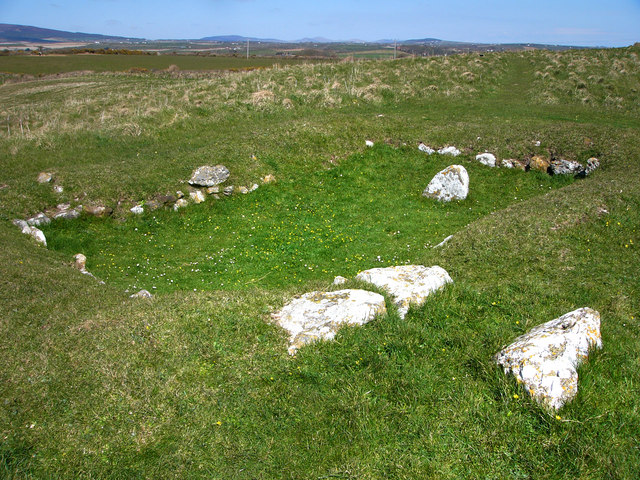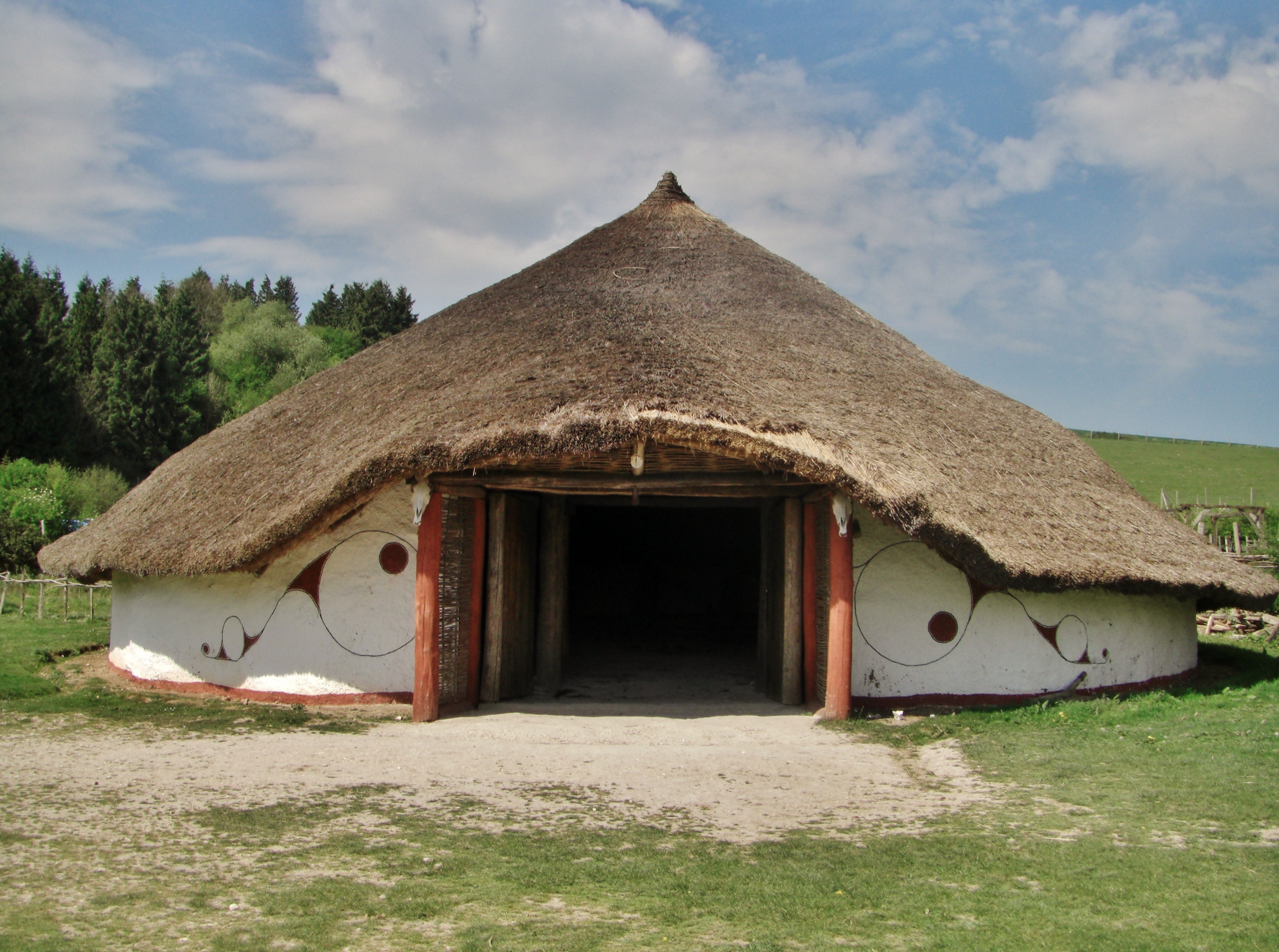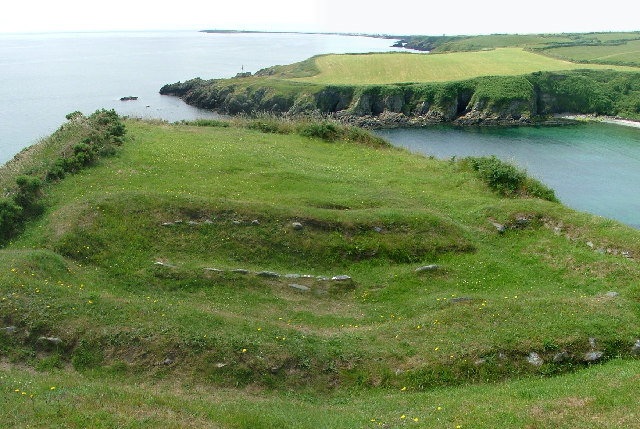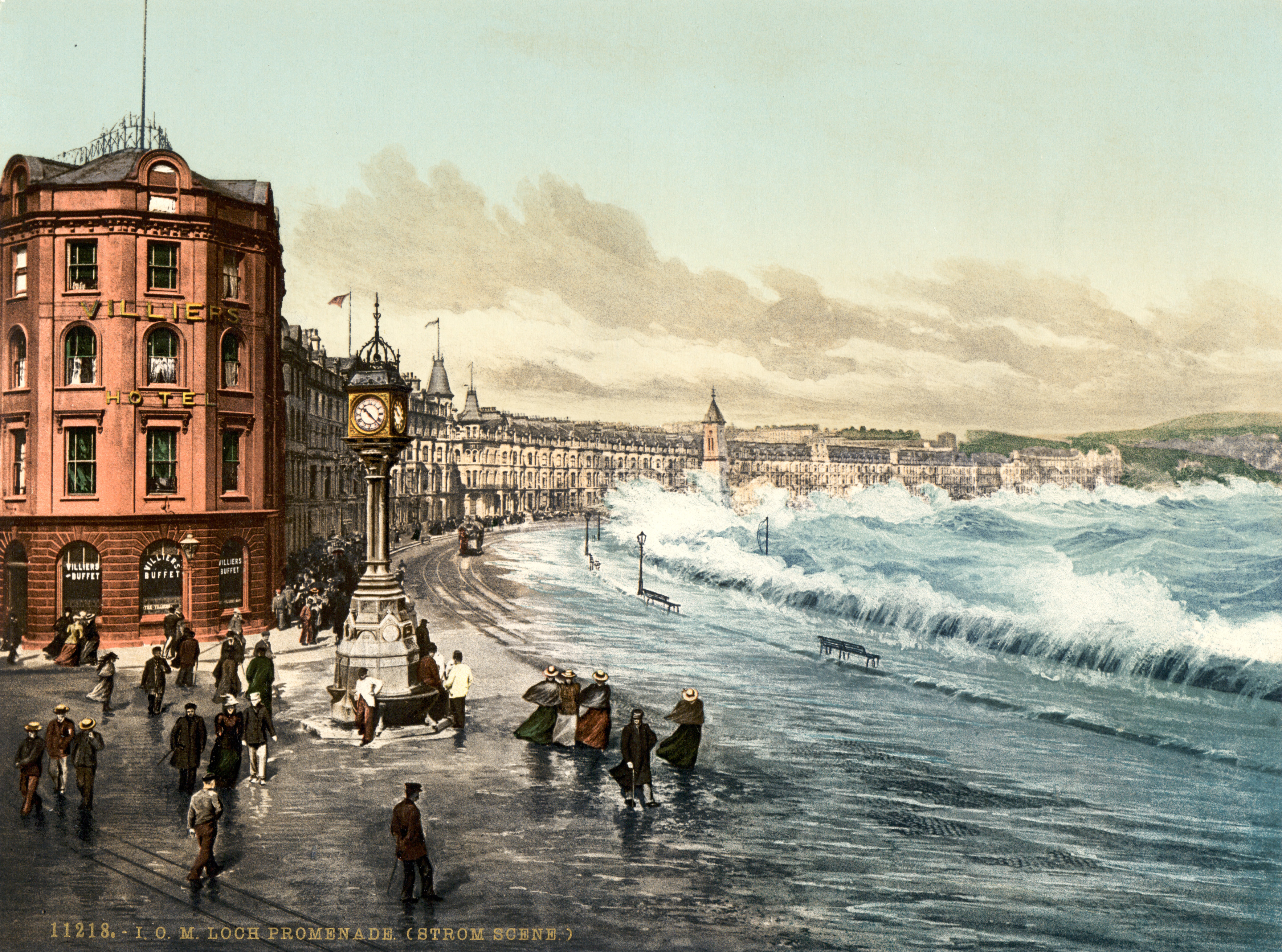|
Balladoole
Chapel Hill, Balladoole is a significant historical and archaeological site in Arbory on the Isle of Man. The site is a short distance from Castletown in the south of the Island. It is located on a small hilltop overlooking the coast. Balladoole has undergone extensive archaeological excavations in the 20th century, most notably in 1944-1945 by German archaeologist Gerhard Bersu who was interned on the Isle of Man during World War II. The site has been in ritual use for millennia: archaeological excavations of the hilltop have uncovered Mesolithic remains; a Bronze Age cist; an Iron Age hill fort; a Christian keeill (a small chapel); a Christian burial ground, and a Viking Age boat burial. Excavations The first major excavation of the site took place towards the end of World War II. German archaeologist Gerhard Bersu and his wife were interned on the Isle of Man in 1940 as "enemy aliens". Bersu was permitted to use a team of internees to conduct excavations of significant ar ... [...More Info...] [...Related Items...] OR: [Wikipedia] [Google] [Baidu] |
Gerhard Bersu
Gerhard Bersu (26 September 1889 – 19 November 1964) was a German archaeologist who excavated widely across Europe. He was forced into exile from Germany in 1937 due to anti-Semitic laws in pre-war Nazi Germany. He was interned on the Isle of Man during World War II where he made several significant archaeological discoveries such as the Viking boat burial at Balladoole. Early life He was born in Jauer in Silesia in 1889 to a Jewish father. He was interested in prehistory from a young age and began his archaeological career while still a school boy, by joining in Carl Schuchhardt's excavations near Potsdam in 1907. In successive years Bersu dug in several European countries such as France, Switzerland, Italy, and Greece. He worked under Hubert Schmidt in the excavations at Cucuteni. Romania. During the First World War he worked for the Office for the Protection of Monuments and Collections on the Western Front. After the war he was attached to the German Armistice a ... [...More Info...] [...Related Items...] OR: [Wikipedia] [Google] [Baidu] |
Manx National Heritage
Manx National Heritage ( gv, Eiraght Ashoonagh Vannin) is the national heritage organisation for the Isle of Man. The organisation manages a significant proportion of the island’s physical heritage assets including over 3,000 acres of coastline and landscape. It holds property, archives, artwork, library and museum collections in trust for the Manx nation. It is the Isle of Man's statutory heritage agency and an Isle of Man registered charity (№ 603). Overview Manx National Heritage is a charitable trust, and a registered charity created by statute as (and still formally known as) the Manx Museum and National Trust. It is governed by a board of trustees. Manx National Heritage's role is to lead the Isle of Man's community in recognising, understanding, valuing and promoting its cultural heritage and identity to a worldwide audience. It is a designated body of the Isle of Man Government, linked via the Department of Economic Development. The Isle of Man Government provi ... [...More Info...] [...Related Items...] OR: [Wikipedia] [Google] [Baidu] |
List Of Hillforts On The Isle Of Man
This a list of hillforts on the Isle of Man. Found across Europe and the British Isles, hillforts are a type of prehistoric archaeological site dating to the Bronze Age and Iron Age, and to a lesser extent the post-Roman period. They are classically defined as small hilltop settlements fortified with earthworks, but many are not located on hills, and probably did not function as forts. Their function is unclear; although conventionally interpreted as defensive fortifications and centres of economic political power, there is little evidence that they were ever attacked, and more recent scholarship has suggested that they may be better interpreted as monuments. According to the ''Atlas of Hillforts of Britain and Ireland'', there are up to twenty eight extant hillforts on Mann itself, and possibly two on the Calf of Man. All but two are on the coast. Ayre * Cashtal Ree Gorree, also known as Balyhamig, a promontory fort located on the northwestern shore of the island. The site w ... [...More Info...] [...Related Items...] OR: [Wikipedia] [Google] [Baidu] |
Arbory
Arbory ( gv, Cairbre) is one of the seventeen historic parishes of the Isle of Man. It is located in the south of the island (part of the traditional ''South Side'' division) in the sheading of Rushen. Settlements in the parish include Ballabeg, Colby and Ronague. Local government For the purposes of local government, the whole of the historic parish forms an electoral ward of the parish district of Arbory and Malew. The Captain of the Parish (since 1998) is Cecil Raymond Gawne. Politics The area of the historic parish is part of the Arbory, Castletown & Malew constituency, which elects two Members to the House of Keys. Until 2016 it was in the Rushen Rushen ( ; gv, Rosien), formally Kirk Christ Rushen, is one of the seventeen historic parishes of the Isle of Man. It is located in the south of the island (part of the traditional ''South Side'' division) in the sheading of the same name. A ... constituency. Demographics The Isle of Man census of 2016 returned a par ... [...More Info...] [...Related Items...] OR: [Wikipedia] [Google] [Baidu] |
Hunter-gatherer
A traditional hunter-gatherer or forager is a human living an ancestrally derived lifestyle in which most or all food is obtained by foraging, that is, by gathering food from local sources, especially edible wild plants but also insects, fungi, honey, or anything safe to eat, and/or by hunting game (pursuing and/or trapping and killing wild animals, including catching fish), roughly as most animal omnivores do. Hunter-gatherer societies stand in contrast to the more sedentary agricultural societies, which rely mainly on cultivating crops and raising domesticated animals for food production, although the boundaries between the two ways of living are not completely distinct. Hunting and gathering was humanity's original and most enduring successful competitive adaptation in the natural world, occupying at least 90 percent of human history. Following the invention of agriculture, hunter-gatherers who did not change were displaced or conquered by farming or pastoralist groups in ... [...More Info...] [...Related Items...] OR: [Wikipedia] [Google] [Baidu] |
Hill Forts
A hillfort is a type of earthwork used as a fortified refuge or defended settlement, located to exploit a rise in elevation for defensive advantage. They are typically European and of the Bronze Age or Iron Age. Some were used in the post-Roman period. The fortification usually follows the contours of a hill and consists of one or more lines of earthworks, with stockades or defensive walls, and external ditches. Hillforts developed in the Late Bronze and Early Iron Age, roughly the start of the first millennium BC, and were used in many Celtic areas of central and western Europe until the Roman conquest. Nomenclature The spellings "hill fort", "hill-fort" and "hillfort" are all used in the archaeological literature. The ''Monument Type Thesaurus'' published by the Forum on Information Standards in Heritage lists ''hillfort'' as the preferred term. They all refer to an elevated site with one or more ramparts made of earth, stone and/or wood, with an external ditch. Many ... [...More Info...] [...Related Items...] OR: [Wikipedia] [Google] [Baidu] |
Historic Sites In The Isle Of Man
History (derived ) is the systematic study and the documentation of the human activity. The time period of event before the invention of writing systems is considered prehistory. "History" is an umbrella term comprising past events as well as the memory, discovery, collection, organization, presentation, and interpretation of these events. Historians seek knowledge of the past using historical sources such as written documents, oral accounts, art and material artifacts, and ecological markers. History is not complete and still has debatable mysteries. History is also an academic discipline which uses narrative to describe, examine, question, and analyze past events, and investigate their patterns of cause and effect. Historians often debate which narrative best explains an event, as well as the significance of different causes and effects. Historians also debate the nature of history as an end in itself, as well as its usefulness to give perspective on the problems of the p ... [...More Info...] [...Related Items...] OR: [Wikipedia] [Google] [Baidu] |
Buildings And Structures In The Isle Of Man
A building, or edifice, is an enclosed structure with a roof and walls standing more or less permanently in one place, such as a house or factory (although there's also portable buildings). Buildings come in a variety of sizes, shapes, and functions, and have been adapted throughout history for a wide number of factors, from building materials available, to weather conditions, land prices, ground conditions, specific uses, prestige, and aesthetic reasons. To better understand the term ''building'' compare the list of nonbuilding structures. Buildings serve several societal needs – primarily as shelter from weather, security, living space, privacy, to store belongings, and to comfortably live and work. A building as a shelter represents a physical division of the human habitat (a place of comfort and safety) and the ''outside'' (a place that at times may be harsh and harmful). Ever since the first cave paintings, buildings have also become objects or canvasses of much artistic ... [...More Info...] [...Related Items...] OR: [Wikipedia] [Google] [Baidu] |
Douglas, Isle Of Man
Douglas ( gv, Doolish, ) is the capital and largest town of the Isle of Man, with a population of 26,677 (2021). It is located at the mouth of the River Douglas, and on a sweeping bay of . The River Douglas forms part of the town's harbour and main commercial port. Douglas was a small settlement until it grew rapidly as a result of links with the English port of Liverpool in the 18th century. Further population growth came in the following century, resulting during the 1860s in a staged transfer of the High Courts, the Lieutenant Governor's residence, and finally the seat of the legislature, Tynwald, to Douglas from the ancient capital, Castletown. The town is the Island's main hub for business, finance, legal services, shipping, transport, shopping, and entertainment. The annual Isle of Man TT motorcycle races start and finish in Douglas. History Early history In the absence of any archaeological data, the origins of the town may be revealed by analysis of the origina ... [...More Info...] [...Related Items...] OR: [Wikipedia] [Google] [Baidu] |
Grave Goods
Grave goods, in archaeology and anthropology, are the items buried along with the body. They are usually personal possessions, supplies to smooth the deceased's journey into the afterlife or offerings to the gods. Grave goods may be classed as a type of votive deposit. Most grave goods recovered by archaeologists consist of inorganic objects such as pottery and stone and metal tools but organic objects that have since decayed were also placed in ancient tombs. The grave goods were to be useful to the deceased in the afterlife; therefore their favorite foods or everyday objects were left with them. Often times social status played a role in what was left and how often it was left. Funerary art is a broad term but generally means artworks made specifically to decorate a burial place, such as miniature models of possessions including slaves or servants for "use" in the afterlife. Although, in ancient Egypt they would sometimes bury the real servants with the deceased. Where grave go ... [...More Info...] [...Related Items...] OR: [Wikipedia] [Google] [Baidu] |
Cairn
A cairn is a man-made pile (or stack) of stones raised for a purpose, usually as a marker or as a burial mound. The word ''cairn'' comes from the gd, càrn (plural ). Cairns have been and are used for a broad variety of purposes. In prehistoric times, they were raised as markers, as memorials and as burial monuments (some of which contained chambers). In modern times, cairns are often raised as landmarks, especially to mark the summits of mountains. Cairns are also used as trail markers. They vary in size from small stone markers to entire artificial hills, and in complexity from loose conical rock piles to elaborate megalithic structures. Cairns may be painted or otherwise decorated, whether for increased visibility or for religious reasons. A variant is the inuksuk (plural inuksuit), used by the Inuit and other peoples of the Arctic region of North America. History Europe The building of cairns for various purposes goes back into prehistory in Eurasia, ranging in s ... [...More Info...] [...Related Items...] OR: [Wikipedia] [Google] [Baidu] |
Clinker (boat Building)
Clinker built (also known as lapstrake) is a method of boat building where the edges of hull planks overlap each other. Where necessary in larger craft, shorter planks can be joined end to end, creating a longer strake or hull plank. The technique originated in Scandinavia, and was successfully used by the Anglo-Saxons, Frisians, Scandinavians, typically in the vessels known as cogs employed by the Hanseatic League. Carvel construction, where plank edges are butted smoothly, seam to seam, supplanted clinker construction in large vessels as the demand for capacity surpassed the limits of clinker construction. (See Comparison between clinker and carvel below.). Examples of clinker-built boats that are directly descended from those of the early medieval period are seen in the traditional round-bottomed Thames skiffs, and the larger (originally) cargo-carrying Norfolk wherries of England. Etymology From ''clinch'', or ''clench'', a common Germanic word, meaning “to fasten ... [...More Info...] [...Related Items...] OR: [Wikipedia] [Google] [Baidu] |





.jpg)




